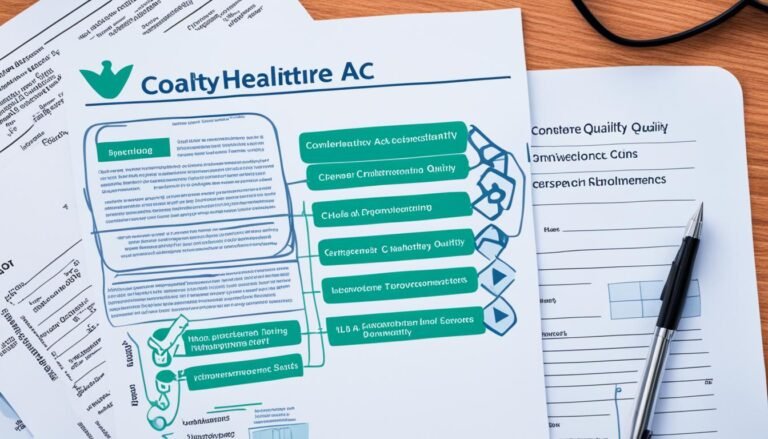Navigating FDA Regulations: A Quick Guide
Did you know the U.S. Food and Drug Administration (FDA) oversees more than $2.6 trillion in products annually? This amounts to about 25 cents of every dollar Americans spend. This highlights the vast influence of FDA Regulations across different sectors. These include pharmaceuticals, medical devices, and food production. It’s essential for all players in these industries to understand and follow regulatory requirements strictly.
From vital medical device regulations to crucial food safety guidelines, the scope of FDA compliance is broad. It touches the core of public health and safety. Businesses must not only grasp the complex drug labeling laws but also actively participate in compliance training. This ensures they stay compliant with the ever-changing legal requirements. Whether you’re just starting in the pharmaceutical industry regulations arena or keeping up with FDA enforcement updates, this guide aims to boost your confidence and knowledge.
Key Takeaways
- Grasping the scope of FDA’s influence is the first step in navigating its complex regulations.
- Compliance with FDA regulations is non-negotiable for businesses in the food, pharmaceutical, and medical device sectors.
- Staying current with regulatory requirements and enforcement practices is vital for maintaining legal and safe operations.
- Effective compliance training programs are essential for both new and established businesses to ensure FDA compliance.
- Securing FDA approval is a rigorous process that demands a strategic understanding of the regulatory landscape.
- Understanding the role of FDA regulations can safeguard consumer health and fortify a business’s reputation.
Understanding the Foundations of FDA Regulations
Navigating FDA regulations starts with a strong base. The FDA oversees the safety and effectiveness of many products. This includes things like drugs for people and animals, medical devices, and our food supply.
FDA compliance is a must. It means following strict rules at every step, from making a product to keeping an eye on it after it’s sold. This ensures companies meet the highest quality and safety standards.
The FDA’s rules aim to make sure only quality products get to us. They cover everything from producing goods correctly to ensuring labels tell the truth. It’s all to keep us safe.
| Aspect | Purpose | Impact on Stakeholders |
|---|---|---|
| Pre-Market Approval | Ensures products are safe and effective before they are available to the public. | Companies must provide substantial scientific and clinical evidence to obtain FDA approval. |
| Good Manufacturing Practices (GMPs) | Mandates manufacturers to consistently produce and control products according to quality standards. | Requires an investment in process and systems to maintain high standards of production. |
| Labeling Regulations | Assures that labels are truthful and not misleading; provides necessary health information. | Demands meticulous attention to product packaging and marketing materials. |
| Post-Market Surveillance | Monitors product safety and effectiveness after they have entered the market. | Companies must track, report, and address any product defects or adverse reactions associated with their products. |
Staying in line with FDA compliance is crucial for relevant companies. Though the rules seem complex, they are key to never risking our health.
The FDA’s guidelines keep getting updated, showing its vital role. They change as we learn more and get new technologies, all to keep us safe.
Understanding the foundations of FDA regulations prepares us to better explore the regulatory process. It’s a path that demands careful planning, constant attention, and a strong promise to meet the FDA’s strict standards.
The Regulatory Lifecycle: From Development to Approval
Bringing a new product to the market is a complex journey, especially under FDA oversight. It’s crucial to understand FDA guidance documents and FDA rulemaking process. These help ensure a smooth journey from development to launch. Here is a pathway these products follow.
- Research and Development (R&D): This phase is all about innovation. Initial studies and tests create the product’s base.
- Preclinical Testing: Before trying on humans, its safety and effectiveness are tested. This often involves lab and animal studies.
- Investigational New Drug Application (IND): Submitting an IND to the FDA is a must for clinical trials. It includes all product data and study plans.
- Clinical Trials (Phases 1-3): These trials involve humans to check safety and effectiveness. Each phase has a special goal, comparing the product to current treatments.
- New Drug Application (NDA) or Biologics License Application (BLA): These contain all data from R&D, preclinical, and clinical studies. They show the product is safe and works.
- FDA Review: Now, the FDA checks everything. If the product meets standards, it gets approved for the market.
- Post-Market Surveillance: Even after approval, the FDA keeps an eye on the product. They check for any adverse effects or long-term issues.
Consulting FDA guidance documents is key at every step. These documents are a big help in understanding the FDA rulemaking process. They offer advice and explain the rules clearly.
| Phase | Objective | FDA Interaction | Documents and Regulations |
|---|---|---|---|
| R&D | Develop and refine product concept | Optional pre-IND meetings | FDA guidance documents |
| Preclinical Testing | Determine safety for human testing | Guidance on testing protocols | Good Laboratory Practice (GLP) regulations |
| IND Application | Request permission for clinical trials | Review and approve IND | IND submission guidelines |
| Clinical Trials | Assess safety & efficacy in humans | Monitor trial progress | Good Clinical Practice (GCP) guidelines |
| NDA/BLA Submission | Seek FDA approval for marketing | Thoroughly review application | NDA/BLA submission requirements |
| FDA Review | Secure official approval | Make approval decision | FDA performance standards |
| Post-Market Surveillance | Ensure ongoing safety & efficacy | Adverse event reporting | Post-marketing safety monitoring guidelines |
For industry pros, knowing the FDA rulemaking process is vital. It affects how products are developed. Joining in on public comments can offer insights into changing standards. This might even shape future rules.
The regulatory path is careful and requires sharp focus. Having a deep understanding of FDA guidance can immensely help. It makes navigating this landscape smoother, leading to successful product launches.
Demystifying the FDA Approval Process
Getting approval for FDA-regulated products may seem full of hurdles. It’s crucial for anyone in the pharmaceutical, food, or medical device sectors. Unraveling the process helps prepare for what’s ahead with the FDA.
Depending on the product type, the FDA approval process varies. Drugs need thorough clinical trials. Medical devices might go through a simpler review, based on their risk level. We will cover what’s common in these processes for a broad understanding.
- Pre-submission: This phase involves defining the regulatory pathway and may include pre-investigational new drug (IND) or pre-market notification [510(k)] meetings with the FDA.
- Clinical trials/Application: For drugs and some medical devices, this step requires the execution of clinical trials, culminating in the submission of a New Drug Application (NDA) or 510(k) notification.
- Review: The FDA reviews the submitted evidence, testing data, and labeling to ensure the product’s safety, efficacy, and quality.
- Inspection: Manufacturing facilities are typically inspected to confirm compliance with Good Manufacturing Practices (GMP).
- Decision: The FDA will either approve the product for market or request additional information, which could extend the review process.
- Post-market surveillance: After approval, the product is subject to ongoing review, including adverse event reports and potentially further studies.
This outline simplifies what is a detailed process. Each step has many requirements and might lead to more discussions with the FDA. Real-life cases often need advice from regulatory experts.
| Product Category | Typical Pathway | Main FDA Concerns |
|---|---|---|
| Pharmaceuticals | New Drug Application (NDA) | Safety, Efficacy, Quality |
| Medical Devices | Pre-market Notification [510(k)], Pre-market Approval (PMA) | Safety, Performance |
| Food Products | Food Facility Registration, Prior Notice | Safety, Sanitary Conditions |
Securing FDA approval is a complex journey but can be navigated. It requires careful preparation, gathering strong data, and clear talks with the FDA. The goal is to protect public health by making sure all FDA-regulated products are safe and effective before they reach us.
Food and Drug Administration (FDA) Regulations: Ensuring Safety and Compliance
The FDA regulations set high standards for public health. They oversee food and drug companies closely. It’s important and legally required for companies to follow these rules. They help keep the public safe and maintain trust. The rules cover manufacturing, marketing, and distribution of food and drugs.
It’s vital for food and drug companies to keep up with FDA updates. This ensures they meet all the needed safety standards. Below is a table comparing FDA requirements for food safety and drug labels.
| Aspect | Food Safety Guidelines | Drug Labeling Laws |
|---|---|---|
| Objective | Prevent foodborne illnesses | Ensure safe usage of medications |
| Key Requirements |
|
|
| Entity Oversight | Food facilities and importers | Pharmaceutical companies and labeling entities |
| Compliance Monitoring | FDA inspections and food product sampling | Review of labeling and promotional materials |
| Reporting | Reportable Food Registry for hazards | Adverse events and medication errors reporting |
The FDA aims to protect consumers. Their rules help prevent food contamination and promote clean production. Drug labeling laws give essential medication usage information.
Understanding and applying these regulations reduces public health risks. Companies can improve their market position. They need to follow and adjust to FDA regulations continually. This ensures ongoing compliance and a safer environment for everyone.
Best Practices for FDA Compliance Training
Making sure your team knows FDA compliance is key. It’s not just about following laws. It also helps build a quality and safety culture. Training varies, from courses to training on the job. This aligns employees with what’s expected by regulators.
The core of training programs is ongoing education and assessment. Teams need updates on rules and to check their knowledge often. This keeps everybody ready to follow FDA rules every day.
Keeping track of all training is also vital, with documentation of all training activities. This shows who knows what and plans future training. It shows you’re serious about meeting FDA standards.
Learning from real-life situations is crucial, too. It helps make FDA rules clear and relevant. Employees learn how to use this knowledge at work.
Tailoring training for different roles makes sure it’s useful. Customized training means everyone gets what they need. This keeps everyone focused and helps remember important details.
| Training Aspect | Description | Benefits |
|---|---|---|
| Continuous Education | Regular updates and assessments on FDA compliance | Keeps employees current and prepared for regulatory changes |
| Documentation | Maintaining records of all training activities | Provides evidence of compliance and training effectiveness |
| Real-life Application | Use of scenarios and case studies for training | Enhances practical understanding and application |
| Role-customized Training | Training tailored to specific job functions | Ensures relevance and effectiveness of training for all roles |
Compliance training is an ongoing learning and growing process. It’s vital to follow these best practices for FDA training. This ensures your team is always equipped to meet FDA standards. With proper training, your organization is set to succeed.
Engaging with the FDA: Commenting on Proposed Regulations
For people in industries regulated by the FDA, knowing how to comment on proposed regulations is crucial. This part of the process allows individuals and businesses to share their thoughts and expertise on possible changes. When the FDA suggests new rules, the public can submit comments. This ensures many viewpoints are heard before the final decision is made.
Making a FOIA request is another way to stay informed about FDA rules. The Freedom of Information Act lets people see government documents and information that was not shared before. To do this, one can use the FDA’s online site or send a written request to the agency.
To submit petitions means asking the FDA to change, add, or remove a rule or order. It’s a way for people and companies to shape policies. They can suggest changes to match the industry’s current needs and new technological developments.
Below is a simple table showing how to work with the FDA on regulations:
| Action | Description | Considerations |
|---|---|---|
| Comment on Proposed Regulations | Providing feedback during the open comment period on regulations pending finalization. | Comments should be evidence-based and clearly articulated to be considered during the rulemaking process. |
| FOIA Request | Requesting access to FDA documents not readily available to the public. | Requests can take time to process, and some sensitive information may be excluded for legal reasons. |
| Submit Petitions | Formally requesting the FDA to create, modify, or cancel regulations or take other actions. | Petitions must be well-researched, and there is no guarantee of immediate response or action from the FDA. |
Through these methods, stakeholders follow FDA rules and help shape them. This activity shows how important it is to take part in making policies. It also shows how the FDA and industries work together. Together, they create regulations that benefit everyone.
The Global Alignment of Pharmaceutical Industry Regulations
The pharmaceutical industry regulations are expanding all over the world. This makes international harmonization very important. Companies can work better across different countries if they follow the same rules. These rules are set by the International Council for Harmonisation (ICH) and the Veterinary International Conference on Harmonization (VICH). This kind of alignment helps get pharmaceutical products from one country to another easily. It also makes sure these products are safe and work well everywhere.
The ICH has created many ICH guidance documents. These documents are essential for drug companies that want to meet international standards. They cover important areas like quality control and clinical safety. These are critical for making, testing, and selling drugs. By following these guidelines, drug development becomes easier and saves time and money.
- ICH Quality Guidelines – Establishing standards for pharmaceutical quality
- ICH Safety Guidelines – Defining the safe use and risk assessment of drugs
- ICH Efficacy Guidelines – Standardizing the protocols for drug trials and studies
The VICH guidance documents, focus on veterinary medicines. They aim to keep animals healthy and safe by ensuring the quality of veterinary products. Following VICH standards helps companies dealing with animal drugs to understand different country regulations. This supports international trade and public health.
International harmonization shows our global promise to public health, advancing science. It creates an effective ruleset for the drug sector that goes beyond borders.
Using the ICH guidance documents and VICH guidance documents helps the industry. It lessens the issues caused by different regulations in different countries. It clears the way to bring health-improving products to people all over the world. For drug companies, knowing and using these global rules is not just about following laws. It’s also a big business advantage in the global market.
Navigating Digital Health and Medical Software Regulations
The healthcare industry is always changing with new technology. This puts digital health regulations and medical software regulations front and center. For those making these technologies and for healthcare providers, knowing and following the rules is key.
Aligning new products with medical software regulations is crucial for success. These rules protect patient privacy and ensure digital health solutions are safe and effective.
It’s important for everyone in healthcare tech to stay updated on regulations, whether for simple health apps or complex software.
Here are the main areas affected by digital health regulations:
- Data Protection and Privacy
- Software as a Medical Device (SaMD) Classification
- Cybersecurity Measures
- Interoperability Standards
Take a look at the table below for a summary of digital health and medical software regulations:
| Regulation Aspect | Considerations for Compliance | Impact on Stakeholders |
|---|---|---|
| Data Privacy | Adherence to privacy laws such as HIPAA, GDPR for patient data | Developers must ensure robust data encryption and consent management |
| SaMD Classification | Understanding FDA guidance for software classification | Correct classification impacts the pathway to market and post-market monitoring |
| Cybersecurity | Implementation of end-to-end cybersecurity protocols | Developers need to prioritize security to protect patient data and device functionality |
| Interoperability | Compliance with standards like HL7, FHIR for healthcare data exchange | Ensures seamless integration and communication between multiple platforms and devices |
While there are many rules in the world of digital health, they are pushing for better safety and innovation. Navigating these regulations is challenging but it leads to safer and more effective solutions.
Conclusion
Mastering the journey of navigating FDA regulations is like charting a course through complex waters. Every buoy and landmark is a crucial guide. At the start, a basic understanding of FDA regulations is essential. This foundation helps build up all the knowledge that comes after.
This guide has shown that the path of regulatory compliance starts with product development. It goes all the way to getting FDA approval. This path requires careful attention and preciseness in the industry.
Creating a strong, informed culture through FDA compliance training is key. This training improves an organization’s integrity and commitment to high standards. The changing nature of FDA regulations also encourages active involvement. It allows for feedback on new rules, creating a team effort in regulation.
As the global market grows, staying updated with international standards is critical. This ensures FDA regulations align globally, making them part of a worldwide health standards symphony.
To navigate FDA regulations well, one must keep learning and actively engage with the FDA. Aligning with both domestic and global regulations is important. This dedication to quality and safety, along with understanding digital health changes, leads to success. In the end, the route to mastering FDA regulations requires knowledge, hard work, and a constant pursuit of excellence.







